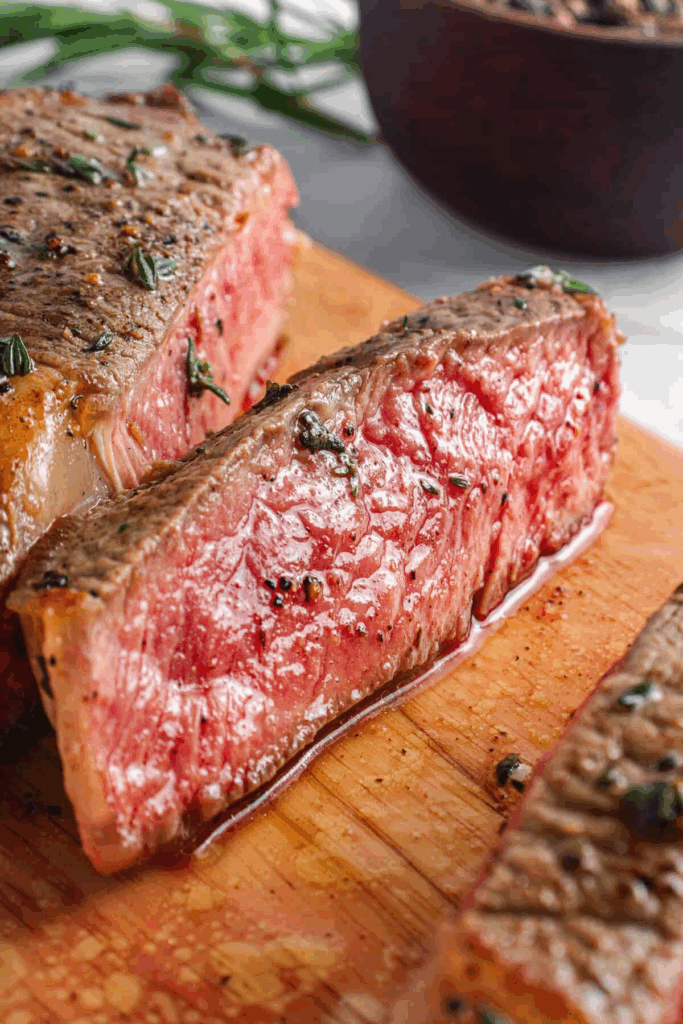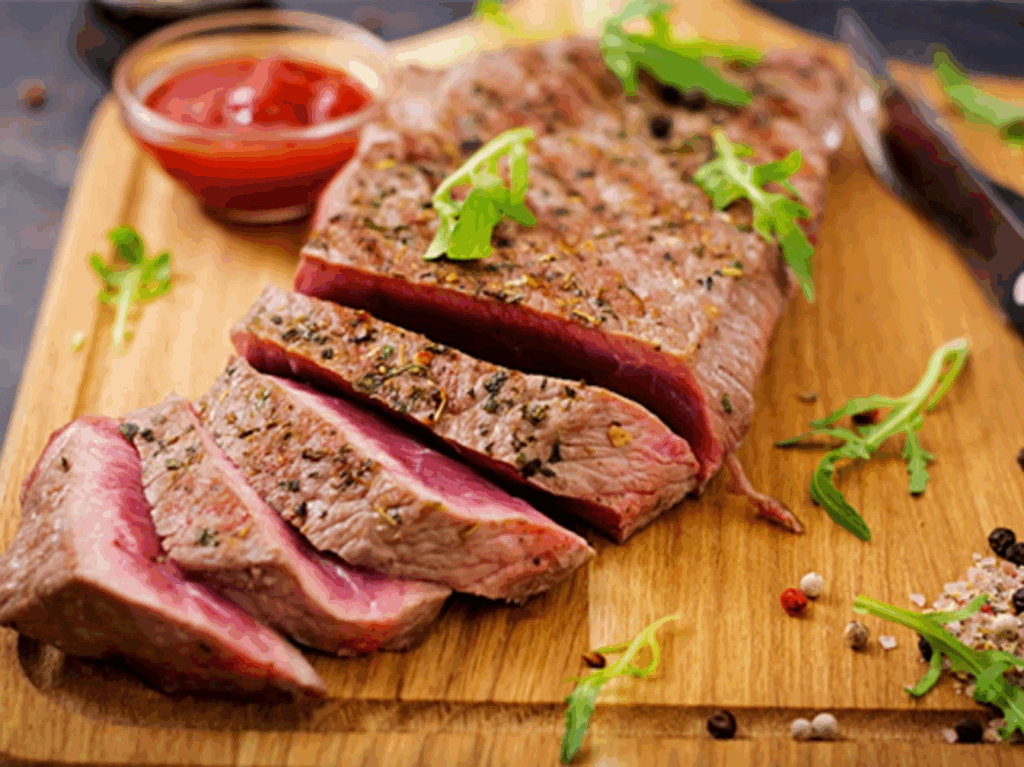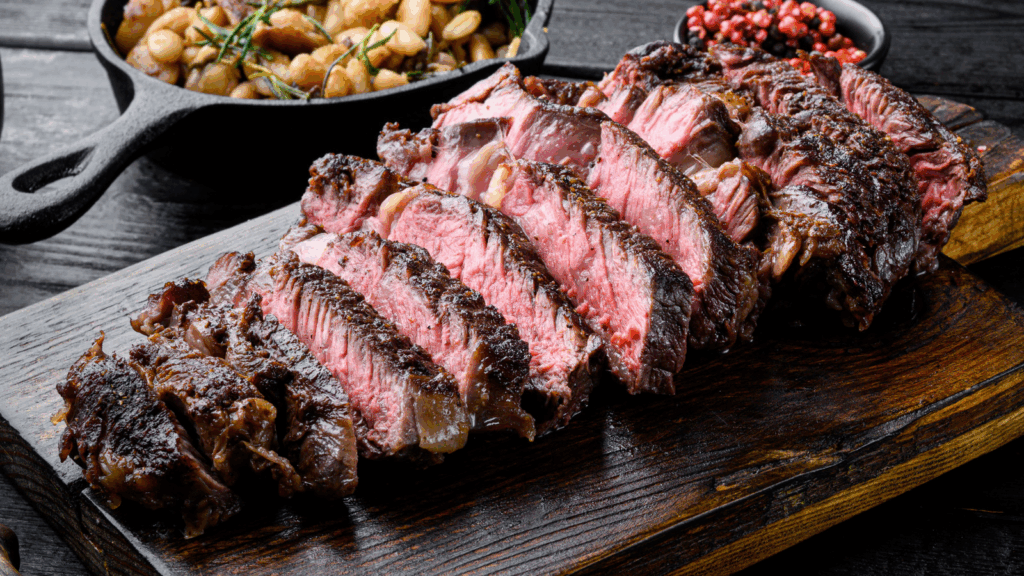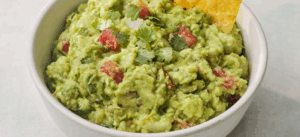How to Cook a Medium Rare steak
How to Cook a Medium-Rare Steak: Full Guide to Perfect Doneness Every Time

As a professional chef, I can tell you with confidence that medium-rare is the gold standard when it comes to steak. It’s the point where tenderness, juiciness, and rich beef flavor converge. The meat stays buttery and pink inside, with just enough resistance in texture to feel satisfying without ever becoming chewy. That’s why it’s the preferred doneness in most steakhouses and chef kitchens around the world.
- Why Medium-Rare Is the Ideal Steak Doneness
- Understanding Medium-Rare: Internal Temperature and Characteristics
- Choosing the Right Cut for Medium-Rare Steak
- How to Prepare Steak Before Cooking
- Essential Ingredients for Cooking Medium-Rare Steak
- How to Cook Medium-Rare Steak in a Skillet (Pan-Searing)
- Oven-Finished Steak: Sear-Then-Bake Method
- Temperature and Doneness Table for Medium-Rare Steak
- Reverse Sear Method for Precision Cooking
- Sous Vide Technique for Medium-Rare Steak
- Pressure Cooker and Microwave Options for Steak
- Common Mistakes When Cooking Medium-Rare Steak
- Best Sauces to Complement Medium-Rare Steak
- Recommended Seasonings and Marinades
- Variations and Recipes Using Medium-Rare Steak
- How to Serve and Plate Medium-Rare Steak Like a Pro
- FAQ: 15 Questions About Cooking Medium-Rare Steak — Answered by a Chef

Why Medium-Rare Is the Ideal Steak Doneness
When cooked medium-rare, the fat within the steak begins to melt, but the muscle fibers haven’t yet tightened or lost moisture. This makes each bite deeply flavorful and naturally tender. Whether I’m preparing a ribeye, filet mignon, or New York strip, I aim for medium-rare if I want the meat to speak for itself. This guide will walk you through how to consistently achieve that ideal doneness, no matter your experience or equipment.
Understanding Medium-Rare: Internal Temperature and Characteristics
The definition of medium-rare steak in a professional kitchen is clear: the center should reach 130°F to 135°F (54°C to 57°C) after resting. This temperature yields a steak that’s red to warm pink in the center with a slight gradient toward the outer edge. The texture is soft and juicy, with surface browning that adds complexity without drying the meat.
A good medium-rare steak isn’t bloody or raw. When done right, the juices run clear but rich, the interior is uniformly warm, and the surface has a deep crust from proper searing. It’s a balance of controlled heat and patience. I always rely on an instant-read thermometer or visual cues refined through years in the kitchen—but for beginners, temperature is the only sure way to know it’s done right.

Choosing the Right Cut for Medium-Rare Steak
Not every steak responds the same to medium-rare cooking. The best cuts for this doneness are those with good marbling, tenderness, and moderate thickness—ideally around 1 to 1½ inches. In my kitchen, I reach for ribeye when I want richness and fat, New York strip for a firmer bite, and filet mignon for buttery tenderness. Top sirloin also works well and is a great value cut if trimmed properly.
What matters most is the balance of muscle and fat. Too lean, and the steak can taste flat at medium-rare. Too thin, and it can overshoot the temperature within seconds. I recommend starting with a quality, well-marbled piece of meat from a butcher or high-end grocery. Grass-fed or grain-finished is a personal preference—I’ve cooked both, but I adjust my seasoning and sear based on how fatty or gamey the meat feels to the touch.

How to Prepare Steak Before Cooking
Preparation begins long before the steak hits the heat. I always bring the steak to room temperature for at least 30 minutes before cooking. Cold meat cooks unevenly and often leads to a cold center with an overcooked outer layer. During this time, I pat the steak dry with paper towels to remove any surface moisture—this is key for a proper sear.
I season generously with kosher salt and freshly ground black pepper, sometimes 30–60 minutes in advance to allow the salt to penetrate the surface. If I’m using aromatics like garlic or herbs, I press them in after salting, not before. I never use oil in advance when pan-searing—only when the steak enters the pan. The natural fat in most steaks helps create a crust when it hits the hot surface, and added oil in prep tends to interfere.
If the steak has a thick fat cap, I sometimes score it slightly with a sharp knife. This helps it render better during cooking without curling the meat. From there, it’s all about handling the steak with care—no stabbing with forks or overmanipulating the muscle. The less you interfere, the better the final texture.
Essential Ingredients for Cooking Medium-Rare Steak
(List format allowed in this section only)
- 1 thick-cut steak (ribeye, strip, filet, or sirloin — 1 to 1½ inches thick)
- Kosher salt (about 1 teaspoon per side)
- Freshly ground black pepper
- High smoke point oil (grapeseed, avocado, or clarified butter)
- 1–2 cloves garlic, lightly crushed (optional)
- 1 sprig rosemary or thyme (optional)
- 1 tablespoon unsalted butter (for basting)
- Optional: Dijon mustard, balsamic reduction, or steak sauce for serving
This core ingredient list keeps the focus on the beef, enhancing it rather than overpowering it. Simplicity here is key—great steak needs very little to shine.
How to Cook Medium-Rare Steak in a Skillet (Pan-Searing)
Pan-searing is my favorite way to cook steak when I want fast, reliable results with maximum crust. I start by preheating a cast-iron or heavy stainless-steel skillet over medium-high heat until it’s nearly smoking. The pan needs to be hot enough to sear instantly. I then add a thin layer of high-smoke-point oil and place the steak in the center without moving it.
For a 1½-inch thick steak, I cook it for about 2 to 3 minutes per side, depending on the cut and temperature of the meat. I look for deep, even browning, not just color but a textural crust. Once both sides are seared, I reduce the heat slightly, add butter, garlic, and fresh herbs, and begin basting. This step adds flavor and keeps the steak moist.
I monitor the internal temperature using a meat thermometer. As soon as the steak reaches 125°F (52°C) in the center, I remove it from the pan. I let it rest, loosely tented with foil, for 5 to 10 minutes. During that rest, it will rise to 130–135°F, reaching the medium-rare sweet spot.

Oven-Finished Steak: Sear-Then-Bake Method
When I cook steaks thicker than 1½ inches, I often use the sear-then-bake method for more even doneness. I start with the same skillet sear—high heat, oil, no movement until a crust forms. Once both sides are browned, I transfer the skillet directly to a preheated oven at 375°F (190°C).
In the oven, the heat gently finishes the interior without overcooking the outside. For most cuts, I leave it in for 4 to 8 minutes, depending on thickness and initial temperature. I always use a thermometer to check the center. As soon as it reads 125°F, I remove the steak and rest it outside the oven. The internal temp climbs to 130–135°F, resulting in an even, rosy center from edge to edge.
This method is ideal for dinner service or when cooking multiple steaks. It allows me to control timing and texture, and it’s less stressful than stove-only cooking when managing several dishes at once.
Temperature and Doneness Table for Medium-Rare Steak
Precision is everything when cooking to medium-rare. Below is the temperature guide I follow in every kitchen I’ve worked in.
| Method | Target Internal Temp (pull) | Rest Temp Goal | Surface Temp Zone | Notes |
| Skillet (pan-sear) | 125°F / 52°C | 130–135°F / 54–57°C | 400–450°F / 204–232°C | Use thick pan, baste with butter after sear |
| Oven-finish | 122–125°F / 50–52°C | 130–135°F / 54–57°C | 375°F / 190°C | Great for 1½”+ steaks, prevents gray ring |
| Reverse sear | 120–122°F / 49–50°C | 130–135°F / 54–57°C | Finish with sear at 500°F | Ideal for control and edge-to-edge pink |
| Sous vide | Set water bath to 129°F | Already finished | Sear at 500°F briefly | Perfect consistency, excellent for beginners |
I always test temperature in the thickest part and avoid touching bone or fat. Carryover cooking is real—don’t wait for 135°F in the pan, or it’ll end up medium.
Reverse Sear Method for Precision Cooking
Reverse searing has changed how many chefs—including myself—approach thicker steaks. Instead of starting with a hot sear, I begin by slow-roasting the steak in the oven at a low temperature, usually 225°F (107°C), until the internal temp hits around 120°F (49°C).
I place the steak on a rack over a tray to allow air circulation. Once it reaches the target, I rest it briefly while I heat a skillet or grill to high heat. I then sear for 30–60 seconds per side, just enough to create a crust without further cooking the interior.
This technique gives me perfect edge-to-edge doneness with no gray band. It’s the most forgiving method and works especially well for ribeye or thick strip steaks. I recommend it for home cooks who want steakhouse-level results without pressure or timing stress.
Sous Vide Technique for Medium-Rare Steak
Sous vide is the most precise method I’ve used for medium-rare steak—especially when cooking for a crowd or prepping ahead. I season the steak, seal it in a vacuum bag, and place it in a water bath set to 129°F (54°C). I cook it for 1 to 3 hours, depending on thickness.
Since the water never exceeds the target doneness, the steak can’t overcook. After sous vide, the steak looks pale, but the inside is perfectly cooked. I finish it with a very hot sear in a skillet or on a grill for just under a minute per side to build crust and texture.
What I love about sous vide is the consistency—it’s nearly impossible to mess up. I often use it for dinner parties or service when I need to hold meat at temperature without sacrificing quality. The only downside is that it requires equipment and a little planning, but the results are foolproof.

Pressure Cooker and Microwave Options for Steak
I’ll be honest—these aren’t my go-to methods for cooking steak, especially if I’m aiming for medium-rare. But I’ve experimented with them enough to offer a few tips when traditional tools aren’t available.
In a pressure cooker, it’s nearly impossible to hit medium-rare unless you’re using a sous vide function on a modern multicooker. Pressure cooking builds heat fast, and the trapped steam tends to overcook beef quickly. That said, I’ve used it for tougher cuts when shredding or braising, but not for a classic seared steak.
The microwave, surprisingly, can warm a steak to medium-rare if you’re extremely careful. I’ve tested this with pre-cooked rare steak that I’ve needed to bring up to medium-rare in a pinch. I place the steak on a microwave-safe plate, cover it loosely, and heat it in 15–20 second intervals at 50% power, checking with a thermometer each time. It’s risky and hard to control, but it’s better than using full power and ruining the texture completely.
Neither of these methods are ideal, but with proper monitoring, they can serve in emergency situations. When in doubt, I always recommend finishing with a hot sear to add flavor and revive texture.
Common Mistakes When Cooking Medium-Rare Steak
Even experienced cooks make mistakes with steak. The most common one I see is starting with cold meat. If a steak is taken straight from the fridge and slapped into a hot pan, it cooks unevenly. The outside overcooks before the inside even gets warm. I always let my steaks rest at room temperature for 30–45 minutes first.
Another big mistake is overcooking by searing too long or skipping the thermometer. Medium-rare is precise—just a few degrees too high and you’re into medium. I’ve ruined beautiful steaks this way early in my career, so now I always measure temperature instead of guessing.
People also tend to skip the resting period, slicing the steak right after cooking. That’s a surefire way to lose all the juices. I always rest my steak 5–10 minutes to let the internal moisture redistribute. It makes a huge difference.
Finally, I often see cooks undervalue crust. A steak’s flavor lives in the browned exterior. If the pan isn’t hot enough or the meat is wet, the steak steams instead of sears. Drying the steak and using high, even heat is non-negotiable for great results.
Best Sauces to Complement Medium-Rare Steak
A well-cooked steak doesn’t need a sauce—but the right one can make it unforgettable. One of my all-time favorites is a simple pan sauce: after searing, I deglaze the skillet with red wine or cognac, scrape up the fond, and stir in butter and herbs. It’s silky and rich.
For freshness, I often make chimichurri—a blend of parsley, garlic, vinegar, olive oil, and chili. It cuts through the richness of the meat and brings brightness. I especially like it with grilled strip steak.
When I want decadence, I finish with garlic herb compound butter—chilled and sliced over the resting steak. It melts slowly, creating a sauce right on the meat. I rotate ingredients by season, often adding blue cheese, lemon zest, or smoked paprika to the butter base.
If I’m cooking for a crowd, I sometimes go with béarnaise or creamy peppercorn sauce, served on the side. A great sauce shouldn’t hide the steak—it should lift it. I always match sauce intensity to the richness of the cut: light sauces for filet, bold ones for ribeye.
Recommended Seasonings and Marinades
I keep seasoning simple when going for medium-rare. Salt and pepper are all you need for a great steak—but when I want a deeper crust or flavor layer, I use dry rubs with garlic powder, smoked paprika, crushed coriander, or even espresso.
I rarely marinate tender cuts meant for medium-rare. Marinades often contain acid, which starts breaking down the meat and can ruin the texture. But for leaner or cheaper cuts, I sometimes use oil-based marinades with herbs and a little soy sauce to boost umami.
When I do season heavily, I let the steak rest after salting for at least 30 minutes. This dry brining allows the salt to penetrate and start forming the outer layer that will become the crust. I never oil the steak before cooking—only the pan.
Steak doesn’t need a lot of interference. I tell my cooks: season generously, but with purpose. Match the seasoning to the cut, not to your spice cabinet.
Variations and Recipes Using Medium-Rare Steak
Once I’ve nailed the cook on a medium-rare steak, I use it across a variety of dishes. One of my favorites is slicing it thin across the grain and laying it over arugula with shaved Parmesan, lemon vinaigrette, and crispy shallots. It’s simple, elegant, and lets the meat shine.
Another is steak tacos, where I thinly slice medium-rare strip or skirt steak and pair it with pickled onions, avocado, and lime crema on grilled tortillas. The contrast between warm meat and cool toppings is unbeatable.
I’ve also used medium-rare steak for grain bowls, with quinoa, roasted vegetables, and tahini dressing. Or, for something heartier, I layer slices over a garlic baguette with horseradish cream and serve as open-faced sandwiches.
Leftovers are rare, but when I have them, I reheat the steak gently in a skillet with a splash of broth. I never microwave it—it overcooks the center and ruins the texture. With care, medium-rare steak remains flavorful and tender even the next day.
How to Serve and Plate Medium-Rare Steak Like a Pro
Presentation matters as much as execution. When I plate a medium-rare steak, I always begin by letting it rest fully—at least 5 to 10 minutes. This ensures that when I slice it, the juices stay inside, and I get clean, vibrant pink centers instead of pooling liquid on the plate.
For thick cuts like ribeye or strip, I typically slice the steak against the grain into half-inch strips and fan them out across the plate. This not only looks refined, but it also makes the steak easier to eat and more consistent in texture from bite to bite. I angle the slices slightly to reveal the color gradient—dark crust leading into the warm pink core.
I pair medium-rare steak with contrasting textures and temperatures. A creamy puree or buttery mash beneath the meat gives richness, while something crisp—like roasted broccolini or fried shallots—adds crunch. A small spoon of sauce or flavored butter to the side (not over the steak) adds aroma without disrupting the crust.
Garnishes should be simple and purposeful: a dusting of flaky salt, a few microgreens, or a light zest of lemon peel. I never overcrowd the plate—medium-rare steak is the star, and I let it speak for itself.
FAQ: 15 Questions About Cooking Medium-Rare Steak — Answered by a Chef
What’s the exact temperature for medium-rare steak?
In my kitchen, I pull the steak at 125°F (52°C) and let it rest until it hits 130–135°F (54–57°C). That gives a perfectly warm pink center with ideal texture and juiciness.
How long should I rest the steak after cooking?
I always rest a steak for 5 to 10 minutes. During that time, internal juices redistribute, and the temperature evens out. If you cut too soon, those juices end up on the plate instead of in the meat.
Can I reheat medium-rare steak without ruining it?
Yes, but gently. I reheat it in a skillet with a splash of broth or oil on low heat, covered. No microwave—it overcooks the center fast. I also re-slice cold steak thin and serve it over salads.
Why is my medium-rare steak gray on the inside?
It was likely overcooked or the heat was too aggressive. I always use a thermometer and avoid letting it pass 135°F. If it looks gray, it’s probably medium or higher.
Should I salt before or after cooking?
I salt before cooking, usually at least 30 minutes ahead. This gives the salt time to penetrate and helps form a crust. Post-salting doesn’t give the same depth of flavor.
Can I cook medium-rare steak from frozen?
You can—but I don’t recommend it unless using a reverse-sear method. I prefer thawing in the fridge overnight. Frozen steaks sear unevenly and are hard to cook precisely.
What’s the best oil to use for searing?
I use high-smoke-point oils like grapeseed or avocado. Butter is for basting, not searing—it burns too fast on its own.
How do I get a good crust without overcooking the inside?
Hot pan, dry surface, and leave the steak alone. Don’t flip too soon. I also pat the steak dry right before cooking for maximum browning.
What’s the best cut for beginners to cook medium-rare?
I recommend strip steak or sirloin. They’re forgiving, flavorful, and easier to handle than ultra-thick cuts. Filet is great too but more expensive.
Can I grill a steak to medium-rare accurately?
Absolutely. I use a two-zone fire—sear over direct heat, then move to indirect to finish. A thermometer is a must on the grill.
Why do some steaks look red even if they’re overcooked?
That’s usually from lighting or certain brines. I trust internal temperature more than color alone—especially under restaurant lights.
Is medium-rare steak safe to eat?
Yes, as long as it reaches 130°F internally and is handled properly. I use fresh cuts from reputable sources and follow basic kitchen hygiene.
Can I sous vide and still get a crust?
Definitely. I always finish sous vide steaks with a hot cast iron sear for 30–60 seconds per side. It gives color, flavor, and texture instantly.
How can I cook steak without a thermometer?
It’s tricky. I recommend practicing with one first. Eventually, you’ll learn by feel—medium-rare gives slightly under your finger, like the base of your thumb when relaxed.
What’s your personal favorite steak to cook medium-rare?
That’s easy: ribeye, bone-in, reverse seared, finished with rosemary butter. The marbling, flavor, and texture are unbeatable when done right.




Post Comment